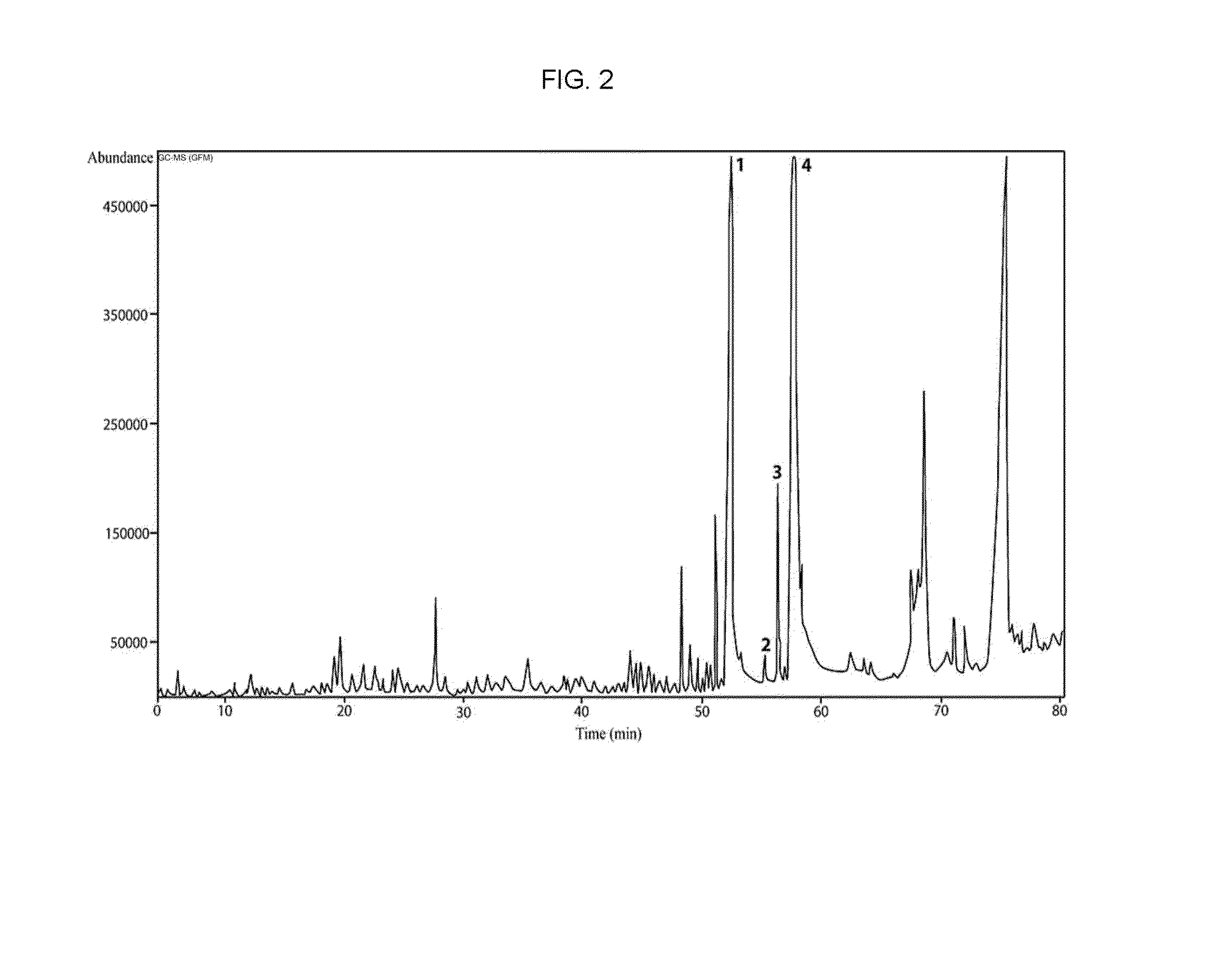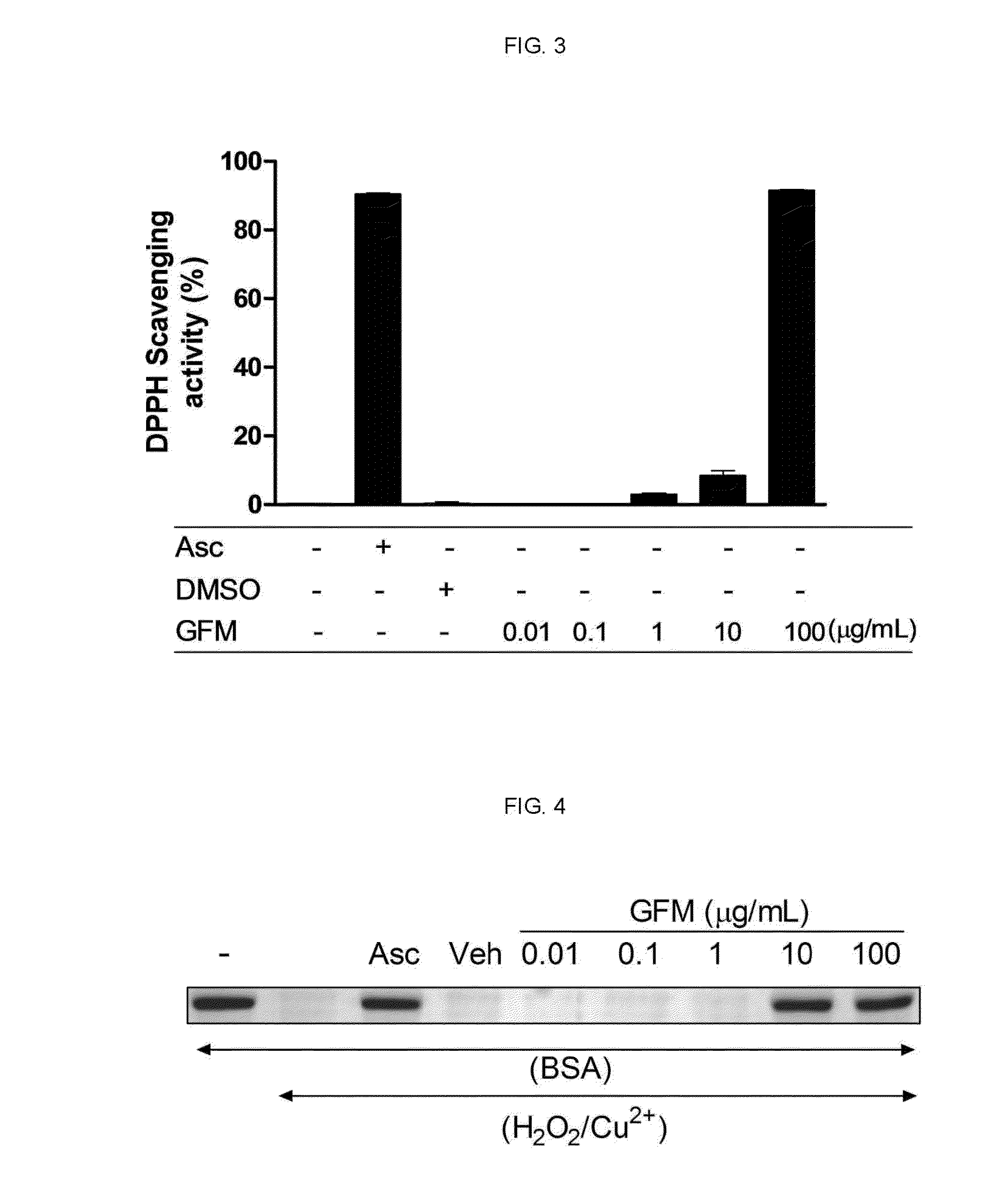Composition and method for enhancing alcohol metabolism
- Summary
- Abstract
- Description
- Claims
- Application Information
AI Technical Summary
Benefits of technology
Problems solved by technology
Method used
Image
Examples
example 1
Extraction of Korean Ginseng Berry
[0055]Fresh Korean ginseng (Panax ginseng C. A. Meyer) berries were obtained from Korea Genetic Pharm Co. Ltd. (Gyeonggi, Republic of Korea). All unripened berries were gathered from at least 4-year-old plants, and whole ginseng berries were steam-dried at 100° C. for 2 h and dried for 24 h at 50° C. These steaming and drying procedures were repeated four to seven times and were then combined, and the final products were prepared after 7 days of drying. Finely ground steam-dried ginseng berries (100 g) were steeped in 1 L of 80% aqueous ethanol for 24 h repeatedly for 3 days at room temperature. The ethanol extracts were combined, filtered through filter paper (Whatman International Ltd., Maidstone, UK), and evaporated. The ethanol extracts were fractionated using a mixture of ethyl acetate and water (1:1 ratio), and then the ethyl acetate layer was evaporated to obtain ethyl acetate fraction (FIG. 1). FIG. 1 is a schematic diagram of an exemplary p...
example 2
Gas Chromatoqtaphy-Mass Spectrometry (GC-MS)
[0056]The ethyl acetate fraction was dissolved in ethanol and identified with an analytical Agilent Technologies 5975C GC / MS instrument (Agilent Technologies, USA) equipped with a CTC CombiPAL autosampler system. Chromatographic separation was carried out using helium carrier gas on an HP-5 column (250 μm×0.25 μm×30 m, Agilent Technologies, USA). A 10 μL aliquot of the sample was injected into a split injector that was operated in split mode using a 5:1 split ratio with split flow and column flow of 5 mL / min and 1 mL / min, respectively. The injector temperature was held at 250° C., and the transfer line was 250° C. The GC oven was held at 50° C. for 3 min, ramped at 2° C. / min to 280° C. and held for 3 min (serum ethanol was detected at 50° C. for 3 min, ramped at 10° C. / min to 150° C. and held for 3 min). The ion source temperature was 250° C. with electron impact ionization energy of −70 V. Data were collected from 35 m / z to 250 m / z using ...
experimental example 1
Radical Scavenging Assay and Protein Protection Assay
[0057]1-1: Radical Scavenging Assay
[0058]DPPH is usually used as a reagent to evaluate the free radical scavenging activity of various antioxidant substances. DPPH is a stable free radical and accepts an electron or hydrogen radical to become a stable diamagnetic molecule. Thus, to evaluate free radical scavenging activity, fractions were allowed to react with the DPPH solution (Espin J. C. et al., J. Agric. Food Chem., 48:648-656, 2000). Each lyophilized fraction was dissolved in dimethyl sulfoxide (DMSO, Sigma-Aldrich) as a stock solution (100 mg / mL) and each fraction was reacted with 0.3 mM DPPH in methanol. Various concentrations of GFM (0.01-100 μg / mL) were reacted with the DPPH radical solution for 30 min at room temperature. Absorbance was then measured at 517 nm. DPPH free radical scavenging activity was calculated using the following equation:
DPPH scavenging activity (%)=[Ac−(A−As)] / Ac×100,
wherein Ac is the absorbance of ...
PUM
 Login to View More
Login to View More Abstract
Description
Claims
Application Information
 Login to View More
Login to View More - R&D
- Intellectual Property
- Life Sciences
- Materials
- Tech Scout
- Unparalleled Data Quality
- Higher Quality Content
- 60% Fewer Hallucinations
Browse by: Latest US Patents, China's latest patents, Technical Efficacy Thesaurus, Application Domain, Technology Topic, Popular Technical Reports.
© 2025 PatSnap. All rights reserved.Legal|Privacy policy|Modern Slavery Act Transparency Statement|Sitemap|About US| Contact US: help@patsnap.com



